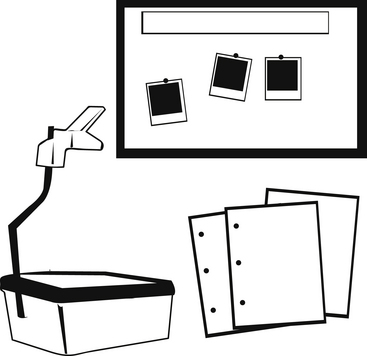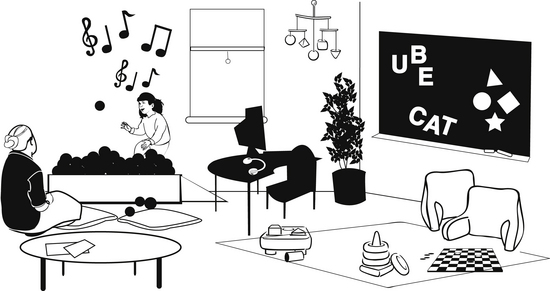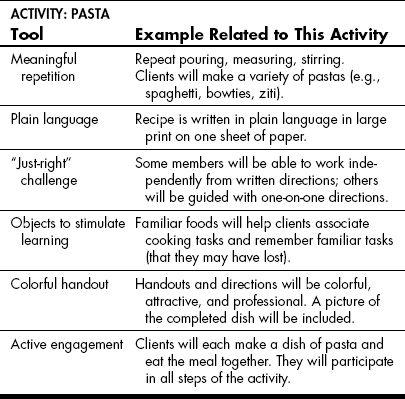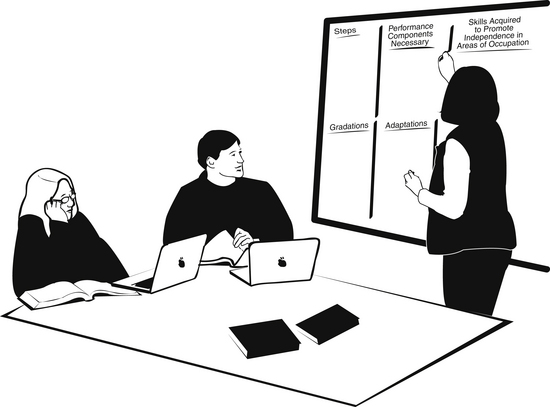Chapter 5 1 Discuss the relevance of teaching and learning from an occupational therapy perspective. 2 List and describe methods of teaching. 3 List the principles of universal design and apply these principles to learning. 4 List and discuss perceptual pathways or styles of learning. 5 Discuss teaching and learning concepts during occupational analysis. 6 Discuss teaching and learning concepts during group processes. The two major categories of method of instruction are direct and indirect.10 The combination of direct and indirect instruction is known as an eclectic approach. The practitioner using a direct method teaches in a formal style. The environment is not a free-choice for instruction. The learner is expected to pay attention. The practitioner uses an autocratic leadership style.1,7 Box 5-1 lists the characteristics of a teacher who uses the direct method of instruction. Using an indirect method involves an informal style of teaching. The environment allows the learner to make choices.1,7 For example, reading, writing, and math centers in a preschool setting allow children to learn on their own. This method encourages self-initiation and expression. The teacher uses a laissez faire leadership style.1,7 Box 5-2 describes the characteristics of a teacher who uses an indirect method of instruction. OT practitioners frequently set up the environment and allow the client to problem solve through the activity with little instruction. This indirect method may help clients gain ability and feel empowered. They may develop unique ways of doing things. Their problem-solving abilities allow them to work through a variety of situations and are helpful for the future. Practitioners also use a direct method of teaching that involves instructing or demonstrating each step of an activity. Often a combination of approaches serves clients best, allowing clients some direct instruction to learn basics before allowing them to problem solve and figure out solutions on their own. See Box 5-3 for examples of each method. Instruction occurs both in formal and informal environments.7 A formal instructional environment is characterized by individual work, emphasis on assessment, and use of external motivators. The result of formal instruction is typically academic achievement. For example, the OT practitioner uses formal instruction during prewriting and handwriting groups. The OT practititioner teaches the steps, strokes, and patterns sequentially. Children complete work independently and are assessed to determine how well they have achieved the needed skills. An informal instructional environment is characterized by freedom in choosing activities and minimal emphasis on assessment or the use of external motivators. This type of environment fosters thoughtful and creative learners. Learners must decide how to do things and develop solutions. Informal environments are helpful for clients who must learn to problem solve. Therefore, this type of learning requires some basic skills and is often used after periods of direct instruction.1,10 The occupational therapy practitioner uses informal instruction during sensory processing groups. Throughout the occupational therapy process a combination of formal and informal teaching styles is applied. The choice and use of teaching tools depend on the content and context of the subject matter (Box 5-4). The objects and materials used in the activity may serve to teach clients. For example, providing an adult who has experienced a stroke with a shirt to put on may remind the client of the technique. The adult may be able to recall putting on a shirt and now needs to figure out how to do this with limited arm use. In this way, the object serves as a reminder to facilitate the learning. Media and methods are terms that an occupational therapy practitioner uses when planning interventions on an individual or group basis. Media is the plural form of the word medium. A medium is the materials used during the intervention process.2 For example, a child engaged in making paper bag puppets uses media that include the paper bag, glue, and other materials and supplies, and the method refers to the set-up, steps of the process, and cleaning up. A method is a means of accomplishing a task.2 OT practitioners use an eclectic approach combining the direct and indirect methods while providing interventions. Examples of therapeutic media are playdough, arts and crafts supplies, and scented markers. Visual aids may be useful to remind clients of key points, sequences, and directions. Visual aids used for teaching can be based in low or high technology. Visual aids provide cues to remind clients of the steps. Examples of low-technology visual aids are picture boards, handouts for sequencing the steps of an activity, and handwritten transparencies projected from an overhead (Figure 5-1). High-technology visual aids include things such as PowerPoint shows or DVDs for teaching. Auditory aids may also be used to facilitate learning. Recorded music incorporated into the learning environment or auditory feedback systems are examples of auditory aids. Many learners benefit from a kinesthetic approach to teaching. This means learning through moving and doing. A multisensory approach using several sensory pathways simultaneously with teaching is often the most successful (Figure 5-2). For example, while working with a preschool child who has autism spectrum disorder, the OT practitioner may incorporate music to help the child focus while engaging the child in movement experiences. Clients learn by doing and OT practitioners help facilitate clients’ engagement in activity. This involves providing clients with plain language (sixth-grade level). Using clear and concise directions to highlight key aspects of the activity helps clients learn. Meaningful repetition provides clients with the practice needed to fully integrate the movements or sequence of steps.6 Learning how to divide the parts of the activity into basic actions is an essential part of practice. Practitioners teach clients by providing the “just-right” challenge, a challenge that is not so easy as to make clients bored nor a challenge that is so difficult as to make clients frustrated. Often, the key to successful intervention is understanding the activity and how to change the demands for specific clients. Active engagement in a variety of activities helps clients learn. Using visual, auditory, and movement methods reinforces learning. OT practitioners rely heavily on learning by doing. In this way, much time is spent in OT teaching clients through “doing.” As clients become actively involved in activities, they learn.6 Table 5-1 provides a completed chart to help students examine the tools they are using in practice. This example shows how a meal preparation activity making pasta can be organized to address each suggested guideline when providing direct or indirect instruction. Role playing helps clients see things from a different perspective. This technique can be effective in helping clients try out new skills and abilities in a safe environment. Clients must understand that they are engaging in a “pretend scenario” and be able to verbalize. Role playing may help clients prepare for new activities. For example, a client may role play the expectations that are required to participate in a community outing. The practitioner may add obstacles to the role play, such as asking the client how he or she might react if someone gets too close on the bus. Role playing may provide clients with some insights into others’ feelings or may allow the client to express feelings. The OT practitioner must carefuly design role playing sessions. These sessions are best performed with a few clients. The case method of instruction offers the learner the opportunity for brainstorming and application of the knowledge being learned. A brief case study is reviewed by the learners. The teacher serves as the facilitator, asking guiding questions. The teacher records the ideas from the learners (Figure 5-3). At the end of the session, the learners come to a consensus as to the best practices and approaches for the particular case. Using the case method of instruction gives the learner more opportunities to explore a variety of options for interventional strategies.
Teaching and Learning
Methods of Teaching
Learning Environment
Tools for Teaching
Teaching Techniques
![]()
Stay updated, free articles. Join our Telegram channel

Full access? Get Clinical Tree


Teaching and Learning
Get Clinical Tree app for offline access











